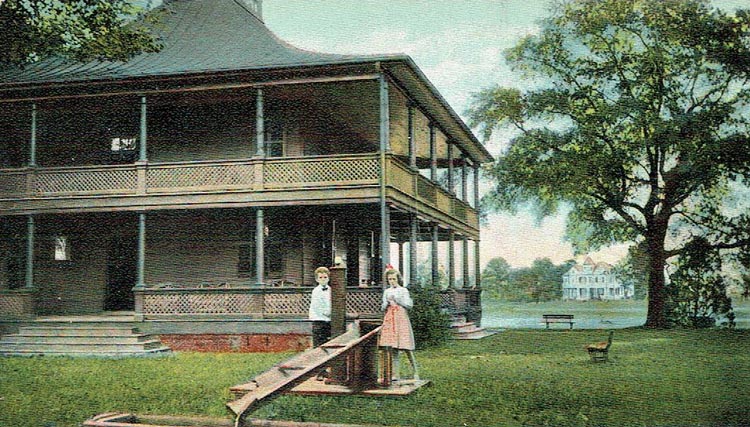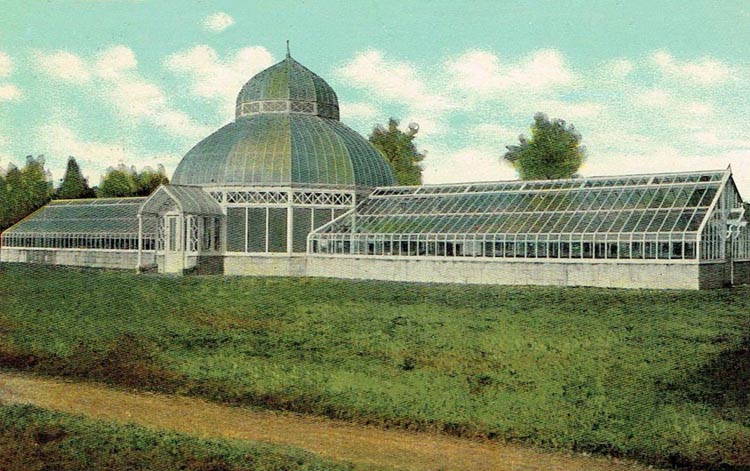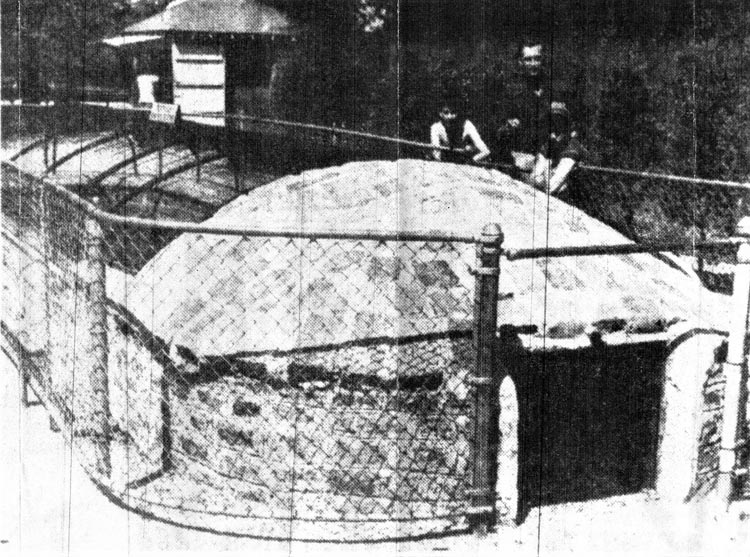Historical Reminiscing with Robert B. Hitchings
Memories of Childhood Days at City Park
Copyright. All rights reserved.
 Spratley House |
 Green House |
Growing up in Norfolk, as a little fellow during the 1950s, I spent many outings at Norfolk’s City Park and Lafayette Zoo with my parents but mostly with Grandmother Hitchings. In my day it was a rather large park consisting of 114 acres, beautiful green grass, lots of trees including tulip trees, hedges, flowers, etc. The paths leading to the animal cages and houses were made up of small pebbles.
Grandma was born Elizabeth Jane Knight (1878-1967) in Norfolk, Virginia. Her parents were Capt. & Mrs. William Henry Knight, both of Norfolk, Virginia. She married my grandfather, Louis Eugene Hitchings, in January 1903.
The park opened in 1892 and included many small tributaries throughout the area. Some were later filled in, making the Lafayette River more attractive and giving the park more acreage. The park buildings in my day consisted of the old Greenhouse, an Entrance building in front to Granby and 35th Streets, the keeper’s house, a log cabin, gazebo with sand, an outdoor stage and the keeper’s house called the old Spratley Mansion.
Grandma loved the Park and I was the baby grandchild that she took along on these outings. To this day, I have wonderful memories of going to City Park with Grandma. She loved her light blue 1950 Chevrolet and loved to drive, which was unusual for a grandmother of that time frame. Her car was her independence to get away from the ordinary routine of the house. Grandma always took the same route to the park, from Granby Street to LaValette Avenue and onto a side street we now call Picnic Gate Avenue. Grandma would always drive up on the soft gravel and park near or right in front the monkey cage.
The Park was always adding new animals. However, it seems like more unusual animals are being added now on a much grander scale than in my day. But one must remember, in those days the City of Norfolk funded the Park or zoo and did not have many organizations or partners to help financially.
I remember the picnics with friends, especially the Arthur Smith family with their daughter Barbara Smith who lived on Powhatan Avenue. They lived next door to my Butt cousins. We were always getting together for a picnic during the spring. For a little fellow, it was so exciting to sit on a colorful tablecloth and have some goodies to eat, mostly consisting of cucumber or peanut butter and jelly sandwiches and deviled eggs that Mrs. Smith made so well. And our drinks (lemonade) were served from a large thermos jug into small paper cups. However, I mostly remember those big squirrels standing up straight and tall waiting for a little morsel of bread. Afterwards we kids would get a box of popcorn for 10 cents to feed to the ducks at the large duck pond. Later, Anne Herbert "Herbie" Butt, my cousin and Barbara Smith and I would roll down the hills while Grandma would be sitting on those large green benches watching us. Sometimes Mrs. Smith would watch too. The hill sloped down towards the large duck pond. It’s amusing what looked so huge as a child was really not that big at all.I remember the old log cabin a little distance from the Barnyard animals that sold cherry and grape snow cones for 5 cents. The cone-shaped cups were very flimsy. After finishing your snow cone, your lips and tongue were either cherry red or grape blue. Popcorn came in a white and red box and the cost was only 10 cents. This log cabin was rustic like, very quaint, dark-brown in color on the outside. Inside seemed so dark. I remembered the Kelly green paint on the window trimmings and especially the old screen door that would bang when we would go out.
After getting popcorn we would sit at the large monkey cage and watch and laugh at the squirrel monkeys running all over the place. I can still remember those cute little monkeys reaching through the fence with their little arms and hands outstretched for some popcorn.
Next to the monkey cage was the otter swimming hole which was a huge attraction for kids. It was made out of cobblestones with a large swimming pool for the otters. As a small child, I would stand and peep over the rail to see the brown-looking otters, swimming and doing acrobatics in the water. Sometimes there would be four or five otters swimming at one time. On top of their cobblestone cage was a sign that read DO NOT FEED THE OTTERS. In back of the otter swimming hole was a small wooden concession stand where one could purchase peanuts, coco-cola and popcorn.
Next Grandmother and I would walk over to see the old black bear in his small cage. She always felt so sorry for that poor black bear and would say, “He needs a large place to roam. He seems to always be sleeping.”
Then Grandmother and I would walk around the outstanding attraction called the Barn-Yard Animals enclosed by a rough wooden fence. On approach, one could smell the Barnyard which had an odor all its own. We could see all the chickens, ducks and geese running around. The roosters were strutting and sometimes you would hear a them crow. Many of the chickens and ducks had been Easter pets that outgrew their welcome at home and were orphaned here at the zoo. Sometimes the chickens had little yellow chicks too.
Next came the Pig Pen and little piglets and a rather large hog sleeping in the mud. After that we visited the rabbit pen that had a colorful, large painted house at the back of the pen. This became a big scene around Eastertime. All the children loved to see the bunnies hopping around.
One day I was looking at the goats and sheep when an old donkey came up to me. Her name was Bonita and she was a friendly nice old donkey who loved popcorn. This particular day the old donkey would not let my finger go. I was trying to go over the fence and Grandma came running to my aid. She took her pocketbook and shook it in the donkey's face, pretending to inflict a blow on the donkey. My finger was released and that donkey left in a hurry. My finger was ok, no marks and I did not cry. Bonita was later moved and confined to the deer pen because of the public insisted upon feeding her.
Mostly I remember the cobblestones all around the park. In 1954-1955 downtown Norfolk was being revitalized. The old buildings were being torn down with the help of the old wreaking-ball and Norfolk was being reshaped into a very modern city. It is fair to say that in 1924 Norfolk had more pre-revolutionary houses than any other state. Today there are only three houses and one church of these still standing.
As the city of Norfolk was reshaping downtown, the question arose what to do with all the old Belgium cobblestones in the streets. Fred Hewett, hortcultist, looked for ways to use these old stones in our City Park and also at Azalea Gardens. He was an ingenious individual and created the otter cage with cobblestones as well as the sea lions area. Soon visitors could see cobblestones all around the park. One such project with cobblestones was an outdoor drama stage where they had young people performing Shakespeare plays. One such play was "Macbeth."
We later would walk over to the Green House or glass conservatory. Inside were many exotic flowers and plants. We kids called it the Hot House because the place was HOT. I remember the huge Banana tree on which many young folks would carve their initials in the huge leaves with a pen knife and also the large orange goldfish the size of my hand swimming around in the greenhouse pond. On one visit to the Green House, I saw two pink flamingos standing on one leg, motionless and staring at me.
The greenhouse was quite large with two extending wings on each side. There was a large dome in the center and during the summer the windows were opened. Norfolk had bought the green house and had it installed in 1906. What is interesting, I cannot find the company that built the greenhouse. In those days most parks bought their greenhouses from Elizabeth, New Jersey, where the Hitchings Greenhouse Company was located. This company installed many greenhouses all over the USA, but I never found any evidence that the Hitchings Greenhouse Company installed one in the city of Norfolk. If that company is any relation to me, it is very remote.
Not far from the green house was the old Joseph R. Spratley Home, now offices of the Superintendent and employees. It was once the estate of Captain Joseph R. Spratley (1814-1890), a former councilman and president of the Merchants and Mechanics Bank. In 1892 his widow, Emma Hunter Spratley (1846-1904), sold the land to Norfolk for a much needed park. My parents went to parties here in the 1930s and Mom loved the veranda that encircled the old house. Grandma used to say as a young girl, “On a spring and summer night one could hear plenty of bull frogs croaking all around that park.” Some of her generation called the place “Bullfrog Park.”
In the opposite direction towards Granby Street was a large gazebo with eight sides and a cone-shaped roof. Inside was a large sandbox, a hang-out for kids who wanted to build sandcastles. One day I remember seeing lots of children just having a grand old time building sandcastles. That day there were so many kids one could not get inside the gazebo for the crowd.
Now my Dad liked the park too. His favorite place was the sea-lions in their new cobblestone den, swimming and barking for fish. My father would imitate these sea-lions with their barks and I would laugh and laugh. They were always bobbing their heads in and out of the water. I remember we were there at feeding time and all those black sea lions came out of the water so fast. I can still hear their barks today. I also remember the sign that was posted on the fence, DO NOT FEED THE SEA LIONS.
Near the sea-lions was a large area of netting for all the different types of birds, small finches and unusual sparrows. I remember seeing two vultures or buzzards up on their perch. They were odd-looking birds, just sitting, no action, with a small brown head and a large brown body.
One Sunday after church my parents made a trip to the park. The Virginian-Pilot newspaper of 1955 was advertising a new exhibit for two pink flamingos purchased in New York. My mother wanted to see these strange-looking birds. She remembered the large flocks of flamingos near St. Augustine, Florida, where my parents went on their honeymoon in November 1936. As a little boy, these two pink birds looked so strange to me. They did not move that day and just stood still, standing on one leg. That Christmas my Dad bought my Mom a Flamingo pin to remind her of her visit to the park.
And I cannot forget to mention the new attraction in June 1958 was Cynthia the Buffalo. In 1960 Cynthia the Buffalo had a baby calf. Elmer was the father and had to be separated from mother and baby as the park officials were afraid that he might do harm to little Winifred. Grandma and I went to see these bison. To me they were huge. When the buffalos came to our zoo, many individuals like myself, wanted to see these creatures. A few months later Park officials were worried about certain mean individuals that were throwing rocks and sticks at the different animals, especially the buffalos. Mrs. Mary Frances Morrissett, an animal rights activist in 1958, had an article in the Virginian-Pilot newspaper about "man’s cruelty" to the zoo animals. I remember different articles about how many individuals, like teens, were teasing these poor creatures, especially the monkeys and chimpanzees. Even today, I cannot understand why people go out of their way to hurt animals.
In January 1958 I remember City Park had lots of folks roaming around the park in search for the “Missing W.” The radio station WCMS had a contest to see who could find their missing W. Joe Hoppel was the man giving clues over the radio to where this missing W was. It was a huge contest and I believe the cash reward was $100.00. In 1958, one hundred dollars was a lot of money. Yes, I was out there with my Dad looking for the missing W too, hoping to win the $100.00. My Mother would say, “There is no W out there, it all a publicity trick from the radio station to get you out in the park.” But I do remember the missing W was found on a snowy day in February near a wooden house cage where the groundhogs lived. Apparently the missing W had been attached to the wooden structure but had fallen in the snow.
Today the park or zoo is large and modernized. New animals have taken up residence and the outdoor concert stage is now gone. The Greenhouse where I loved to watch the gold fish swim and to look at all the exotic plants was taken down in 2001. The old large stately Spratley mansion is long gone, taken down in the 1970s, as well as the gazebo with its large sandbox. The concession stands and the log cabin where I bought my popcorn and snow cones are things of the past, along with the Barnyard animals that predominated the park so long ago. They are fond memories of my childhood days.
However, it is still a lovely park with beautiful green lawns, shade trees and new buildings and lots of new animals. It has grown from a small park into a fine Zoo .
But there is one thing that is still standing and that is the old granite monument to Mayor James G. Riddick (1861-1918), the only monument erected to a Norfolk Mayor. This old monument was placed in City Park on November 21, 1925, designed by Lawson & Newton. On the front is a bronze profile of the former mayor with the inscription, “Physician, Philanthropist, and Friend.” It is visible from the intersection of 35th and Granby Streets and is a reminder of the former mayor that the people of Norfolk looked up to, loved and adored. This is the Norfolk City Park that I remember.
Otter house* * * * * * * * *
Robert B. Hitchings is a seventh generation Norfolk resident, graduating with an Associate's Degree in Biology from Old Dominion University and BA in history from Virginia Wesleyan University. During his studies he was awarded a scholarship at Emmanuel College, Cambridge, England, and he was an exchange student at Brooks-Westminster College, Oxford, England. From 1999-2014 he worked as head of the Sargeant Memorial History Room at Norfolk Public Library, and since then has headed the Wallace History Room at Chesapeake Public Library. He is also the President of the Norfolk County Historical Society, and for six years was a columnist for The Virginian-Pilot. Robert may be reached at nchs.wallaceroom@gmail.com
